Modern Fights in 6 mm: Wargaming in a smaller scale (and painting an army in a day or two!)
If you played any wargaming set of rules in 15mm on a standard 1.80 x 1.20 m tables, you’ll notice every wood becomes a parking lot. With armies like Russians or Iranians, deploying dozens of BMPs or cheap Chieftains, you end up with crowds behind buildings or floods of transports hiding under every available tree. It’s not something wrong in the rules – they work just fine – but with the scale of the troops: 15mm vehicles on a standard table seem often simply too big.
We talked a lot in our local Milan “X Legio” club, and we got an idea: change the scale. From the 15mm we moved to the 6mm, less than one third, to see if the games improved. Spoiler: they did!
In this feature, we’ll talk about how to build a solid 6mm force, where and what you need to buy, how to assemble and how (fast!) you can paint it. In the next two features we will try some set of rules: Team Yankee and A Fistful of Tows.
Where to buy
We chose the GHQ miniatures, for they have more models than the BF army lists ask for. We divided the armies, so every player had a different rooster, and I chose – as always when I start a new wargame – a British army. For what we’ve seen, GHQ best shop in Europe is in Germany – they have almost all the range and can ask for a replacement if needed in a few weeks.
First good news: 6mm armies are really cheap. Comparing to Team Yankee point system, my full 100 points British army cost around 100 Euros. The only pieces really costly are flying units; a single Harrier or Helo cost as much as 5 tanks, but in the Milan Club we agreed to use a single plane for a full wing for saving some money.
Assembling the army
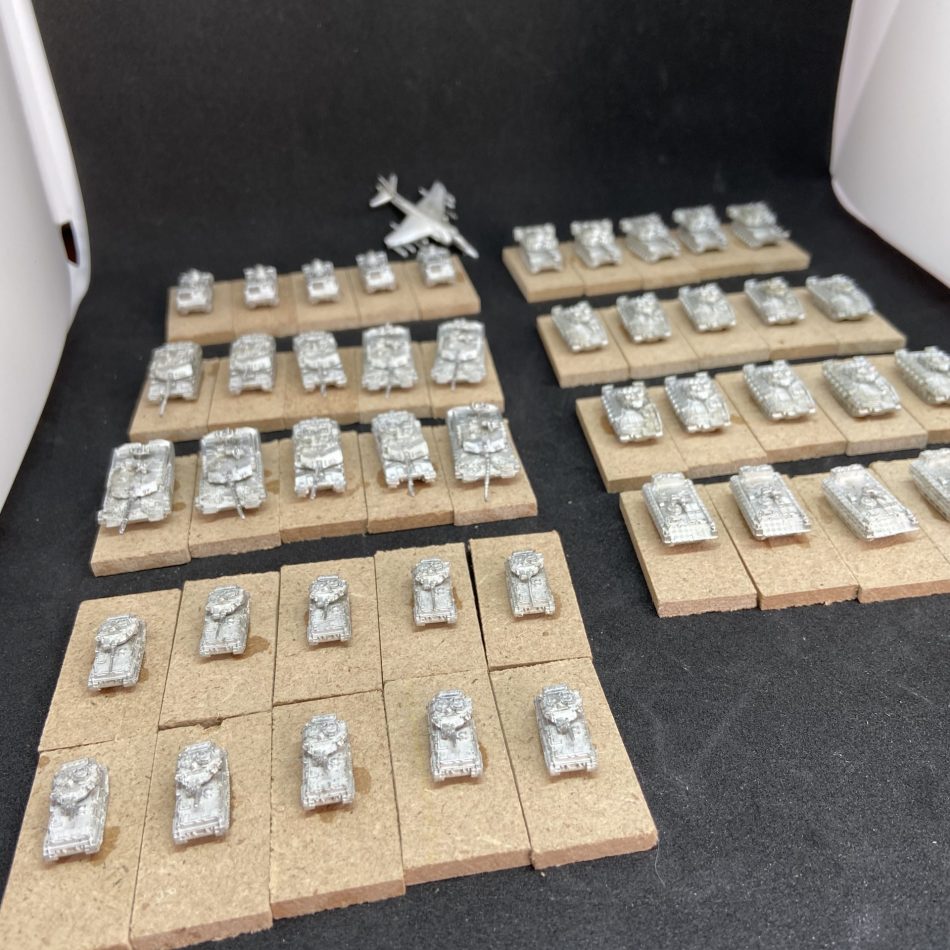 The British army assembled and based. The only tricky parts are the plane and the machine guns.
The British army assembled and based. The only tricky parts are the plane and the machine guns.
The 6mm vehicles are almost ready out of the box: you just need to glue the turret to the tank body, or add the machine gun on the top of the vehicle. The only difficult part of my army was the Harrier, with a full choice of bombs and missiles. You need the usual 15mm equipment (super glue, cutters, and so) plus some good small tweezers since you can’t place the machine guns in the correct position on the turrets with your finger. Also, you need some visual reference since they don’t have any “assembly instructions” (except in the Harrier box).
Painting the army
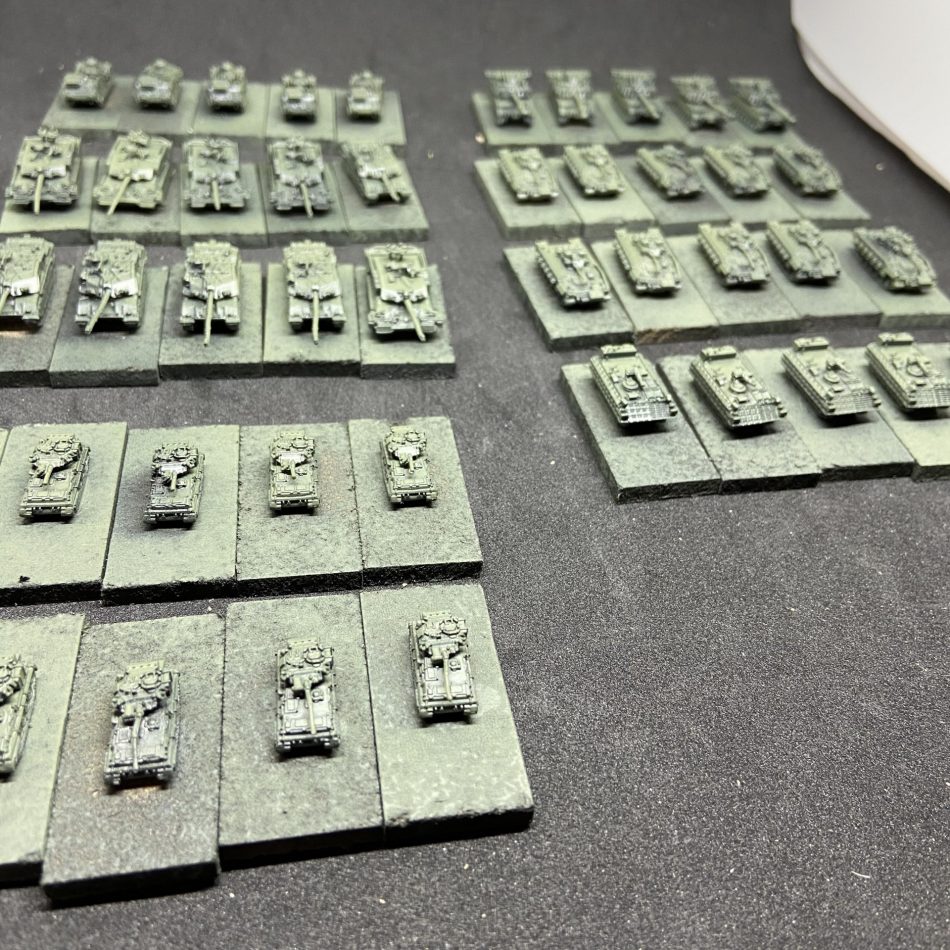 The army after a simple green base coat. Actually, you can play even at this stage, if you want.
The army after a simple green base coat. Actually, you can play even at this stage, if you want.
You can easily paint all your army in one day – I did, actually! British 1980-ish army has a typical two-colour camo, green and black.
Since the miniatures are so small, I suggest having a black undercoat on all your assembled units. It’s better to basecoat the whole army in black, then do a second pass with the green. Once dry, lightly drybrush with 30% US Dark Green (893 Vallejo) + 70% Pastel Green (885) to sharpen the edges.
You can easily do the black stripes with a .20 or .25 airbrush. Once finished, gently drybrush the entire model with Brown Sand (876) adding some white, to highlight the edges. To finish the model, use a dark brown on the tracks and wheels to simulate the mud (I use Murfang Brown from Games Workshop).
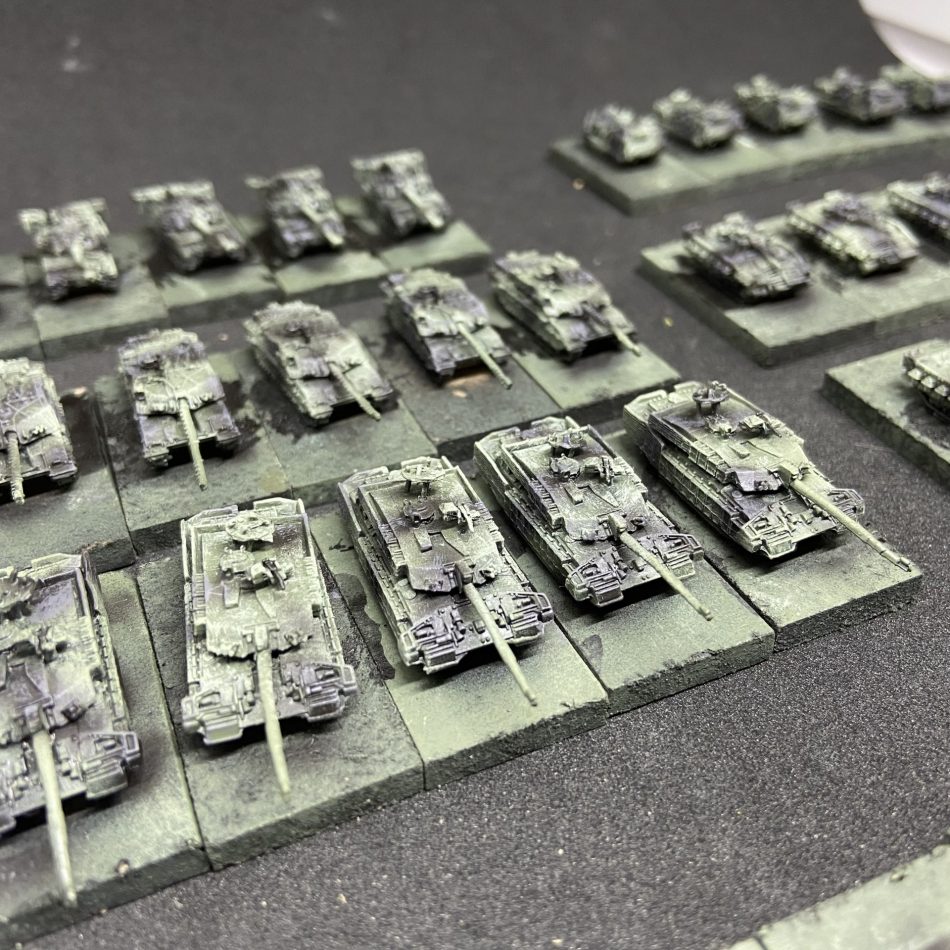 Green base, black stripes, and drybrush: much better, but you can still do some more detail!
Green base, black stripes, and drybrush: much better, but you can still do some more detail!
You can then work on some details – for example, some brown/orange exhausts or a warmer tone of green for the Anti-Air missiles on the Rapiers, but honestly it’s difficult to see them on the table in that scale.
It’s perfectly possible to can paint the whole army in a day or two – actually, the only distraction is to wait for the basecoats to dry!
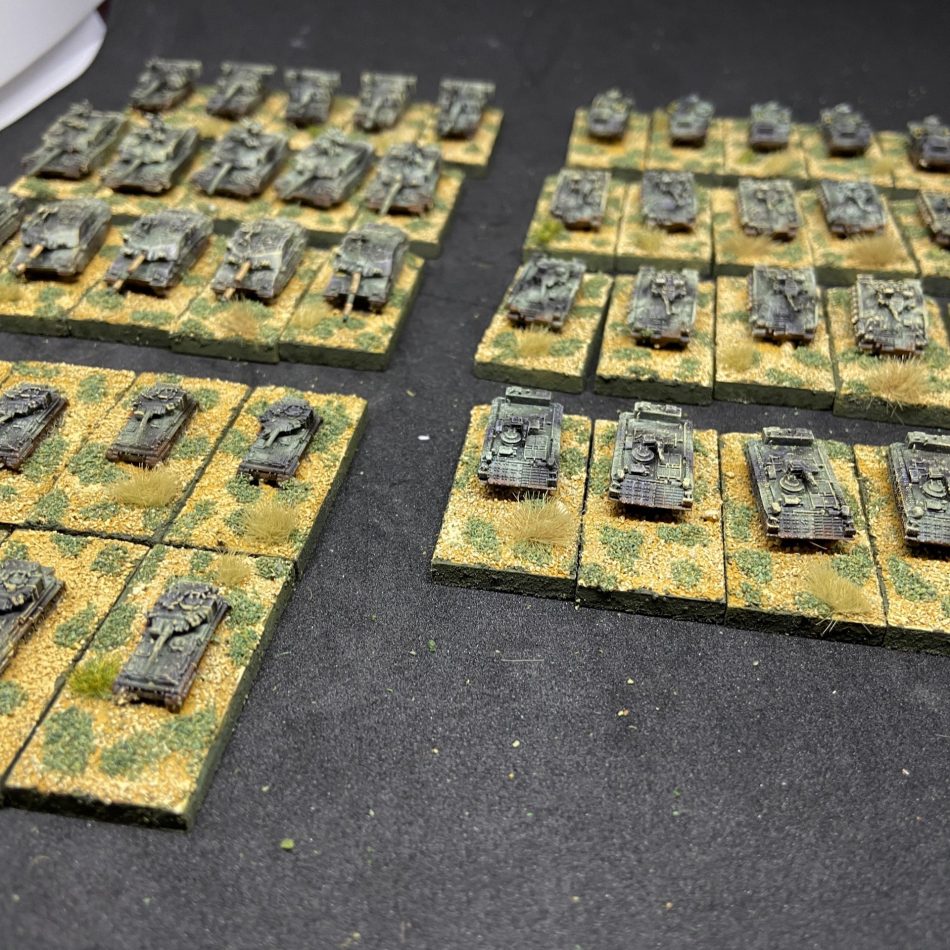 Tanks, scouts and artillery ready! The light brown base is very good to make the model stand out.
Tanks, scouts and artillery ready! The light brown base is very good to make the model stand out.
Infantry
I left the tin soldiers on the sprues, and base coated black and then green, followed by a gentle drybrush in a green lighter tone. A single pass of brown (the same Murfang Brown we used on vehicles’ tracks) on faces, hands, and anything wood or leather, highlighting the faces and hands with a skin pink. British uniforms had three colors: green, brown and lighter brown, so you can pinpoint in a single pass stripes in brown (again, Murfang Brown) and Brown Sand (or anything similar to Iraqi Sand from Battlefront). Weapons and boots will be in black, while webbing and canvas should be done in a different green tone. A final brown wash to smooth the effect.
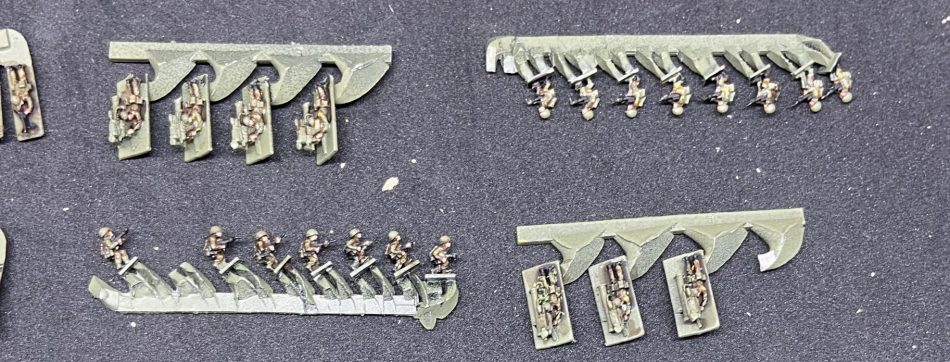 Infantry will be a bit longer if you want to have the three-colors uniform, but it’s still perfectly doable.
Infantry will be a bit longer if you want to have the three-colors uniform, but it’s still perfectly doable.
Basing the army
We agreed to use a 4×2 cm base for each tank/vehicle/infantry unit. Extremely good for me, since I have tons of bases like that for my DBMM armies. The base is useful to handle the vehicles without actually touching them. We also agreed to have 2x2cm bases for all “small” BF bases, like Milan or mortar units.
Just use the “PVA glue + sand” technique () to have your army based in a couple of hours. I suggest using light sand colors, since a light base enhance a dark vehicle, and applying spots of grass and bushes around the base. It’s difficult to find 6mm bushes, so you can cut the 15mm into three and use small tufts around vehicles’ tracks.
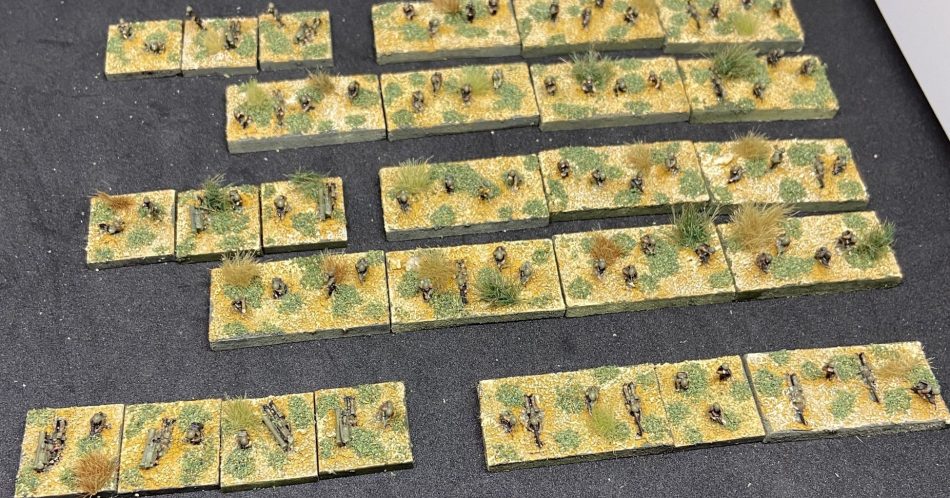 The infantry platoons based: the bases are 4×2 cm or 2×2 cm.
The infantry platoons based: the bases are 4×2 cm or 2×2 cm.
Buildings and terrains
For woods and scrubs, we used the same terrain for Team Yankee battles: just choose the smaller patches of grain fields. We just painted some smaller trees, you can find easily in model train shops or on Amazon. For buildings, we searched our cellars for old games like GW Epic or Battletech, or you can find some 3D models for free on . Also, a guy from our club – being a 3D artist – designed some buildings of the Eighties – and he is doing a Kickstarter right now, selling the 3d files so you can print the buildings at home ().
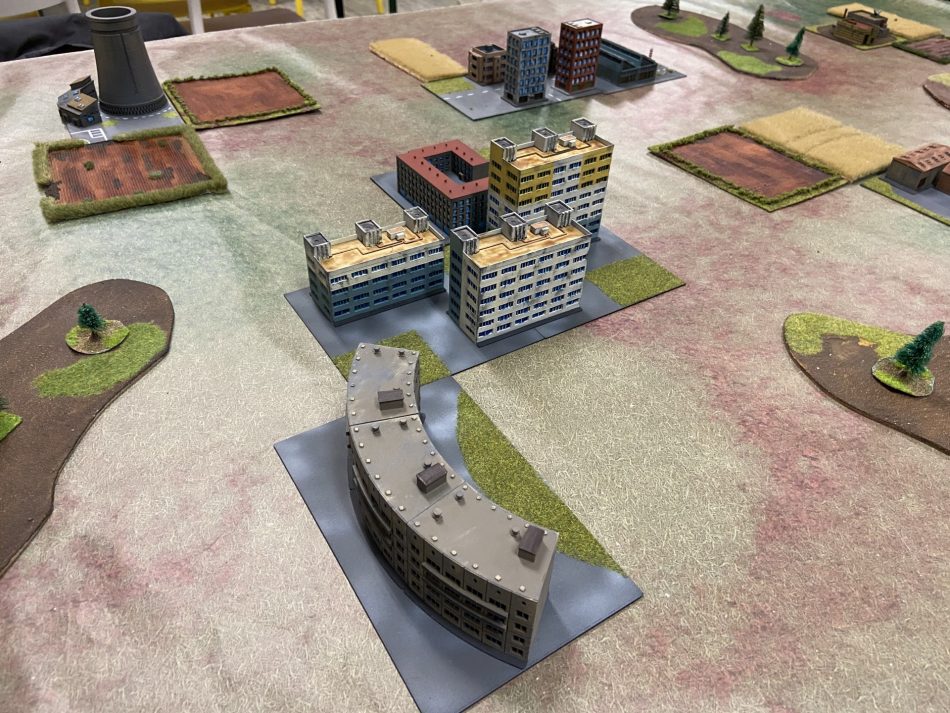 So far, so good: we have the army and the buildings: next time, we will try Team Yankee rules with this new scale!
So far, so good: we have the army and the buildings: next time, we will try Team Yankee rules with this new scale!

Very impressive. We play TY at 36 pts in 15mm to stop the overcrowding but it really limits the game. I’m really tempted by 6mm.
I’ve got some 6mm Dutch AIFVs from https://www.butlersprintedmodels.co.uk/ , you can hardly see the ribbon lines on them .
As for basing infantry for TY , https://lasercraftart.com/cube4/6mm-accessories.html .
send the images! paglianti at gmail.com
Paolo i’m still waiting for H&R to add the Dutch infantry to the website .
NEM300 NCO’s one with Uzi & grenadier (3 figures 1 of each type)
NEM301 Mitrailleur 7.62 mm MAG (LMG) team prone (3 x 2 man team)
NEM302 M72 LAW (5 figures)
NEM303 84mm Carl Gustav (5 figures)
NEM304 Offices & RTO(1 x RTO & 2 x different Officers)
NEM305 Mitrailleur 7.62 mm MAG on tripod (GPMG) team (1 MG and 3 crew)
NEM306 Browning 0.5″ on tripod team (1 MG and 3 crew)
NEM307 81mm mortar & crew (1 mortar & 3 crew)
NEM308 Artillery crew – standing (4 figures)
NEM309 M47 Dragon (5 figures)
NEM310 Pioneer digging (5 figures)
NEM311 Minedetector (5 figures)
NEM312 Artillery crew – kneeling (3 figures)
NEM313 FIM-92 Stinger & gunner
NEM314 Observer with Uzi (5 figures)
NEM315 Infantry strip (5 figures)
Keep talking, you have caught my attention…
I just ordered a GHQ 6mm Israeli Army for Fate of a Nation. Darn you Paolo ?
ahahaha 🙂
We’ve played a number of games using GHQ 1/285 scale figures keeping the ranges as prescribed in TY. It certainly opens the battlefield up even with 100 point armies and the ranges look more realistic. Also, Hinds don’t have the parking lot in the air feel. Problem is many players are heavily invested in 15mm. My suggestion is try a 6mm scale game if the opportunity is there and see what you think.
That might be a reason people don’t want to try 10/12mm as well ?
Sell your 15s, buy 6mm, and probably pocket some cash. Harder part is convincing others to do the same. Perhaps buy both sides?
Like the pics in the article but not sold on the oversized (for some vehicles) bases.
We play TY in 6mm using the rules as written, the only change we made was to use BF Bases for the Infantry putting Large on Medium and both Medium and Small on Small Bases. As the article highlights you can buy a complete army for easily a 3rd the cost. Not hard to talk most gamers into jumping in if you show them the benefits.
I had tons of 6mm from playing from the late 1970s! Really the best scale for post WW2 whichever rules you use.
The 6mm Team Yankee FB site is good for info.